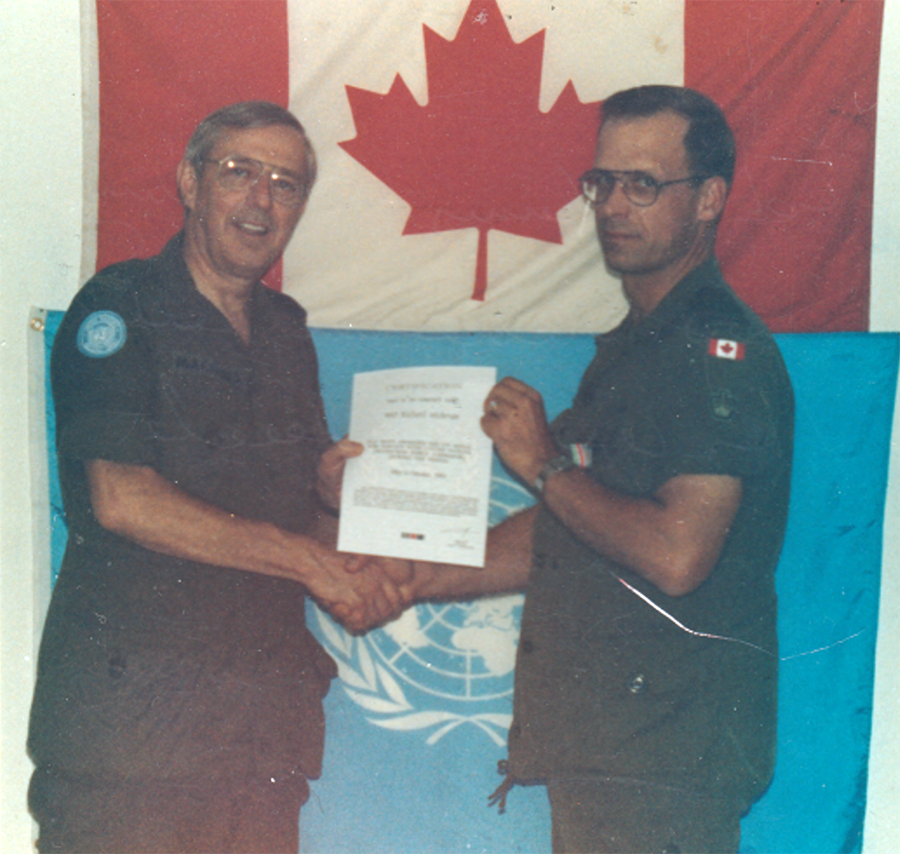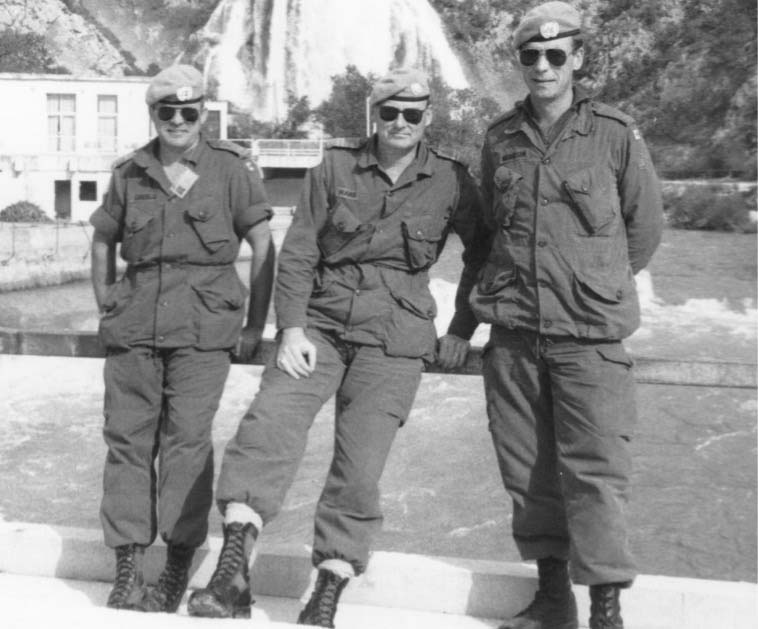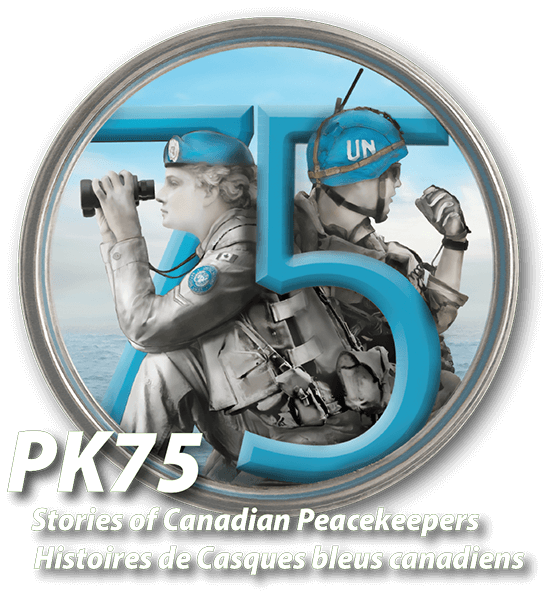

Barrington Passage, NS, Canada
Rick Nickerson
Current Location: Qualicum Beach, BC, Canada
My team and I landed at the airport in Zagreb, Croatia on 1 May 1993 in the bright sunshine and approximately 95 degrees Fahrenheit. As we were getting off the aircraft, a Russian built Mig-21 did a “touch-and-go” on the runway and, although there was no immediate sign that we were in a war zone, it was obvious things were different.
We were sent to Camp Polom, a former Yugoslavian Army Base near Daruvar in UN Sector West. On the air-conditioned, double decked bus ride from the Zagreb Airport there had been little sign of the war. A few flattened houses and some large holes in some other buildings were all that we initially saw. That first night our section was housed in a concrete building and the obvious sign of where we were was a six-inch hole through one wall and a matching 10-inch hole in the opposite wall in the room. This wasn’t Camp Wainwright, AB!
Much went on through the six months we were working there, including the Medak Pocket incident. My experience on a re-supply trip into the surrounded town of Srebrenica in the summer of 1993 is the story I want to relate to you here.
At the time, the Royal 22nd Regiment (VanDoos) were providing UN security for the surrounded town of Srebrenica within Bosnia-Herzegovina. Srebrenica was a Bosnian-Muslim enclave that had been surrounded during the war by the Serbian Army. I accompanied seven large trucks carrying fuel, rations, and water to the Vandoos. The trip should have taken a day but with many checkpoints, not having the “correct” paperwork and “Serbian inspections” to make sure we were carrying what we said we were, it took two long, hot days. We stayed for the night, both ways, at a large, paved area near the border between Croatia and Serbia. The highlight was that south of us — about 10 kms away — we could see and hear the artillery duals going on in Bosnia. We crossed bridges that were build by the Romans, hung ballistic blankets in the windows of the trucks, and put metal screens down over the windscreens. Through the towns our trucks were pelted with rocks by the Serbians who thought we were supplying the Bosnian Muslims.
Entering the Srebrenica area, the hills were bare. There were signs indicating a war had been fought there recently — houses demolished, burned out hulks of vehicles, bomb craters, and, when we got into town, utter destruction. The high rises had chimneys sticking out of window openings on all levels — the town had not had electricity for a year, and everyone was burning wood to keep warm in the winter. People were wandering around the town and almost everyone was begging. The bank in town had been hit by a mortar round and everyone had money, but there was nothing to buy. Cigarettes were currency — you could barter for anything with cigarettes. At night, the UN conducted food drops on a field outside of town. The people were being shot at for trying to get the packages that were dropped. The Canadian armoured personnel carriers of the Vandoos, scarred and looking “weary”, were the only thing moving in town on a regular basis. The Vandoos were the only reason that Srebrenica still had Muslim inhabitants. At night, the town resembled a scene from the movie “Escape from New York”. Fires here and there and people moving around in the dark. Ironically, the only thing in town that moved around other than the Vandoos was a brand-new armoured land rover, painted white and carrying the CNN news crew around.
This experience stayed with me. The utter hopelessness of the people in Srebrenica, men, women, and children, and the impossibility of us or anyone else to effectively do anything about it was disheartening. We now know that there was a massacre there of more than 8000 men and boys in 1995 that was designated as an act of genocide by the International Court of Justice.
At home in Kingston, my garage had burned down. No-one hurt but its importance was difficult to sort out in my own mind.
Biography
Richard Nickerson was born to World War II veterans Kathleen and Charles Nickerson and grew up in Barrington Passage, NS. After Barrington Municipal High School, he got married and decided to sign up for the Canadian Armed Forces. Basic Training in Cornwallis, NS, in January of 1975, was followed by trades training in Kingston, ON as a Communications Research Operator. Rick got his first posting to CFS Leitrim in Ottawa, ON, and the next three years were shared between Leitrim, CFB Kingston, ON, and a six-month stint in CFS Alert, NT. In 1978, Rick applied for a remuster to Intelligence Operator (MOC111) and was accepted.,
That fall, Rick started school again in CFB Borden, ON at the Canadian Forces School of Intelligence and Security. In April 1979, Rick further volunteered for parachute training, received the training at CFB Edmonton, AB, and was posted to the Canadian Airborne Regiment at CFB Petawawa, ON. During three years with the Airborne Regiment, Rick completed 61 parachute descents, worked on exercises at CFB Petawawa, in northern Norway, CFB Borden, the United States (Fort Bragg, North Carolina and a special forces base in West Virginia), Earlton, in Northern ON, and a parachute drop and mock attack of a Pine Tree Line Radar Station in Northern ON in January!
In 1982, Master Corporal Nickerson was posted to CFB Greenwood’s Defence Intelligence Analysis Centre (DIAC). The DIAC supported three squadrons of Aurora Anti-Submarine aircraft. During Rick’s posting there, he utilized his imagery training in processing the imagery produced by the Aurora. Rick was also sent to the Canadian National Exhibition in Toronto to showcase the imagery display at the Armed Forces Exhibit. Rick saw experience on many of the Aurora patrols, logging over 100 hours as a “part-time” aircrew.
In 1985, Sergeant (Sgt) Nickerson was posted to CFB Shearwater, Dartmouth, NS. Working in Base Operations as part of a small Intelligence office, Rick briefed base personnel and Sea King Helicopter squadron personnel primarily on Soviet Equipment. Rick was fortunate to accompany the Sea King crews as “part time” aircrew, logging over 60 hours flying in that aircraft. At CFB Shearwater, Rick got to experience Air Force exercises with the American Navy and American National Guard squadrons, as well as weekly briefings to the Base Commander and Squadron Commanders, and regular liaison with Navy HQ in Halifax on Intelligence matters.
In 1988, Sgt Nickerson was posted to Yellowknife, NT and joined Northern Region Headquarters (NRHQ) in Yellowknife as the Headquarters G2 (Intelligence Officer). Promoted to Warrant Officer, Rick was involved in Imagery, and provided many briefings, both to his own HQ personnel and all sorts of visiting personnel. Rick’s job involved “running” the briefing area, working as headquarters Security Officer, and providing the Intelligence function to the HQ. Rick saw much of the Northwest Territories in support of the Canadian Rangers, and on search and rescue training (as a qualified Ground Search Team Leader and a Search Manager) During this time, Rick completed his Senior Leadership qualification, and was involved in ground searches in the north in conjunction with the RCMP. At one point, Rick accompanied the Commander of Northern Region when he visited a Russian Ice Station that had wandered into Canadian waters west of Mould Bay, NT.
In 1992, Warrant Officer Nickerson was posted back to CFB Kingston, ON, and the Intelligence Company of the First Canadian Division. Supervising an Intelligence Analysis cell that, among other tasks, worked on country orders of battle and terrain analysis of areas where the Canadian Armed Forces might be involved. One of these was the Former Yugoslavia. In March 1993, Rick joined about 60 other support personnel for training at CFB Wainwright, AB, prior to being deployed as the second rotation (roto) of Canadian Forces to United Nations Protection Force Former Yugoslavia (UNPROFOR) We arrived in the Former Yugoslavia on the 1st of May 1993.
After the UNPROFOR tour, Rick returned to 1 Div until 1995 when he was fortunate to be posted back to Yellowknife and Northern Region HQ. In 1997, Rick resigned and retired to Yellowknife after 23 years with the Canadian Armed Forces. Rick presently lives in Qualicum Bay on Vancouver Island with his wife of 52 years. Rick and Trish have a son in Yellowknife, a daughter in Winnipeg, and a total of eight grandchildren.

Major-General MacInnis and WO Nickerson receiving UN scroll at Camp Polom 1993.

Unknown Canadian liaison Captain, Captain Nick Ward, Warrant Officer Rick Nickerson, vicinity Bihac, Bosnia-Herzegovina, 1993.


